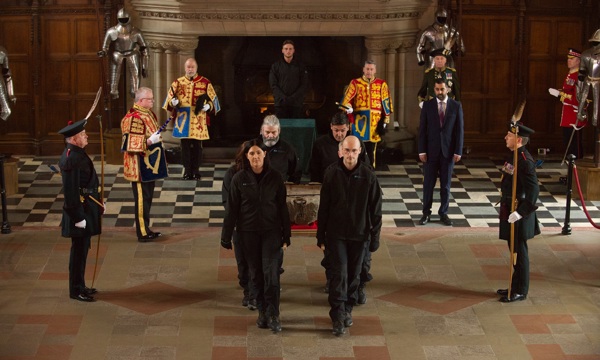A ceremonial procession from the Castle’s Great Hall marked the temporary departure of the Stone from Scotland, which was led by the Lord Lyon King of Arms - the monarch’s representative in Scotland - and attended by the First Minister Humza Yousaf, in his capacity as the Keeper of the Great Seal of Scotland, one of the Commissioners for the Safeguarding of the Regalia.
The Stone will now make its way to Westminster Abbey, where it will be placed in the Coronation Chair for the ceremony, before returning to Scotland and display in the Crown Room at Edinburgh Castle in the weeks that follow.
Historic Environment Scotland (HES), who care for the Stone of Destiny and the other Honours of Scotland on behalf of the Commissioners for the Safeguarding of the Regalia, have worked with Police Scotland and other partner agencies to ensure the Stone can be transported safely and securely.
A number of different teams within HES, with a range of specialist expertise, have been involved in preparing the Stone for its journey to Westminster Abbey for the Coronation. Ahead of its move, the Stone has undergone thorough assessment by the organisation’s stone conservators. The Stone will be transported in a special carrier constructed largely from Scottish oak, which has been made by HES’s in-house joinery team in collaboration with the organisation’s stone conservation team. Collections management principles have been used to ensure the carrier is well designed to protect the Stone in transit.
Kathy Richmond, Head of Collections and Applied Conservation at HES, said:
It is a tremendous privilege for HES to play its part in such a significant and historic occasion, as the Stone of Destiny leaves Edinburgh Castle for the first time in over 25 years.
“It is also a great responsibility to ensure the safe voyage and return of such an important national symbol, and one which has required the care, skill and expertise of a range different specialist teams across our organisation. It is fitting to have the opportunity to celebrate that work today.
“We are working closely with the Conservation team at Westminster Abbey on the installation of the Stone into the base of the Coronation Chair, using the latest techniques and technology.”
First Minister, Humza Yousaf, said:
“The Stone of Destiny has a rich and varied history and has been used for centuries in coronations. It will play an integral part in the Coronation of King Charles III and Queen Camilla.
In my role as Keeper of the Great Seal of Scotland, I am one of the four Commissioners all appointed by Royal Warrant to safeguard the Regalia of Scotland, which includes the Stone of Destiny.
“One of the duties of the Commissioners is to ensure that the Stone is made available for use in Coronations and that it is subsequently returned to Scotland.
“I look forward to seeing the Stone take its place in the Coronation Chair when I attend the ceremony on 6 May.”
The Lord Lyon said: “This occasion is not only historic but underpins the traditions and values of Scottish life.
“The Stone has played its role in many Royal occasions, and it is fitting it returns to Westminster Abbey to have its rightful position in the Coronation of Their Majesties.
“It will be in safekeeping and returned to Scotland for future events.
“I am fortunate to work with a professional and committed team facilitating the move. Scotland should be proud of their work, as I am."
The Stone of Destiny has been used for centuries in the coronations of monarchs and the inauguration of Scottish kings. The earliest use of the Stone and exactly how and when it became associated with king-making remains unknown, but legends around its origin strongly link it with kingship and the emergence of Scotland as a nation. The last Scottish king to be inaugurated using a Stone at Scone was John Balliol in 1292.
In 1296, following his invasion into Scotland during the Wars of Independence, England’s king, Edward I, removed the Stone from Scotland along with the other royal regalia. Around 1300 he had a chair built and installed at Westminster Abbey in London, designed to hold the Stone. This chair is now known as the Coronation Chair.
The Stone was used in the coronation ceremonies of the monarchs of England and, later, Great Britain. James VI was crowned James I of England in Westminster Abbey on 25 July 1603, the first ruler of ‘Great Britain’ to be enthroned on the Stone of Destiny.
The Stone of Destiny was officially returned to Scotland in November 1996 and put on display at Edinburgh Castle on St Andrews Day of that year.
About Historic Environment Scotland (HES)
- We are the lead public body charged with caring for, protecting, and promoting the historic environment. We will lead on delivering Scotland’s first strategy for the historic environment, Our Place in Time.
- Historic Scotland, Scran, Canmore, The National Collection of Aerial Photography (NCAP), The Engine Shed, Stirling Castle, and Edinburgh Castle are sub-brands of HES.
- View our press pack and keep up to date by registering for media release email alerts. If you wish to unsubscribe, please contact us.
Follow Historic Environment Scotland
Twitter: @HistEnvScot | @welovehistory
Facebook: @HistoricEnvScotland | @VisitHistoricScotland
Instagram: @HistEnvScot | @historicscotland
For further information, please contact:
Claire Mullaney
Historic Environment Scotland Media Office
07721 959 962
communications@hes.scot

